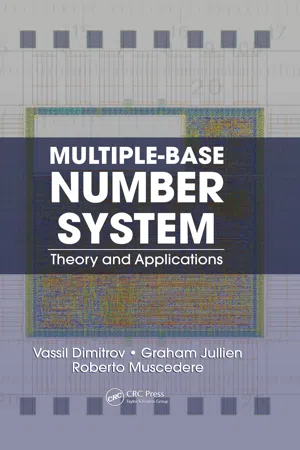
Multiple-Base Number System
Theory and Applications
- 294 pages
- English
- ePUB (mobile friendly)
- Available on iOS & Android
About this book
Computer arithmetic has become so fundamentally embedded into digital design that many engineers are unaware of the many research advances in the area. As a result, they are losing out on emerging opportunities to optimize its use in targeted applications and technologies. In many cases, easily available standard arithmetic hardware might not necessarily be the most efficient implementation strategy.
Multiple-Base Number System: Theory and Applications stands apart from the usual books on computer arithmetic with its concentration on the uses and the mathematical operations associated with the recently introduced multiple-base number system (MBNS). The book identifies and explores several diverse and never-before-considered MBNS applications (and their implementation issues) to enhance computation efficiency, specifically in digital signal processing (DSP) and public key cryptography.
Despite the recent development and increasing popularity of MBNS as a specialized tool for high-performance calculations in electronic hardware and other fields, no single text has compiled all the crucial, cutting-edge information engineers need to optimize its use. The authors' main goal was to disseminate the results of extensive design research—including much of their own—to help the widest possible audience of engineers, computer scientists, and mathematicians.
Dedicated to helping readers apply discoveries in advanced integrated circuit technologies, this single reference is packed with a wealth of vital content previously scattered throughout limited-circulation technical and mathematical journals and papers—resources generally accessible only to researchers and designers working in highly specialized fields. Leveling the informational playing field, this resource guides readers through an in-depth analysis of theory, architectural techniques, and the latest research on the subject, subsequently laying the groundwork users require to begin applying MBNS.
Frequently asked questions
- Essential is ideal for learners and professionals who enjoy exploring a wide range of subjects. Access the Essential Library with 800,000+ trusted titles and best-sellers across business, personal growth, and the humanities. Includes unlimited reading time and Standard Read Aloud voice.
- Complete: Perfect for advanced learners and researchers needing full, unrestricted access. Unlock 1.4M+ books across hundreds of subjects, including academic and specialized titles. The Complete Plan also includes advanced features like Premium Read Aloud and Research Assistant.
Please note we cannot support devices running on iOS 13 and Android 7 or earlier. Learn more about using the app.
Information
1
Technology, Applications, and Computation
1.1 Introduction
1.2 Ancient Roots
1.2.1 An Ancient Binary A/D Converter

(See color insert)
Four-thousand-year-old binary number system.
1.2.2 Ancient Computational Aids
1.3 Analog or Digital?
1.3.1 An Analog Computer Fourier Analysis Tide Predictor
Table of contents
- Cover
- Half Title
- Title Page
- Copyright Page
- Table of Contents
- Preface
- About the Authors
- 1. Technology, Applications, and Computation
- 2. The Double-Base Number System (DBNS)
- 3. Implementing DBNS Arithmetic
- 4. Multiplier Design Based on DBNS
- 5. The Multidimensional Logarithmic Number System (MDLNS)
- 6. Binary-to-Multidigit Multidimensional Logarithmic Number System Conversion
- 7. Multidimensional Logarithmic Number System Addition and Subtraction
- 8. Optimizing MDLNS Implementations
- 9. Integrated Circuit Implementations and RALUT Circuit Optimizations
- 10. Exponentiation Using Binary-Fermat Number Representations
- Index